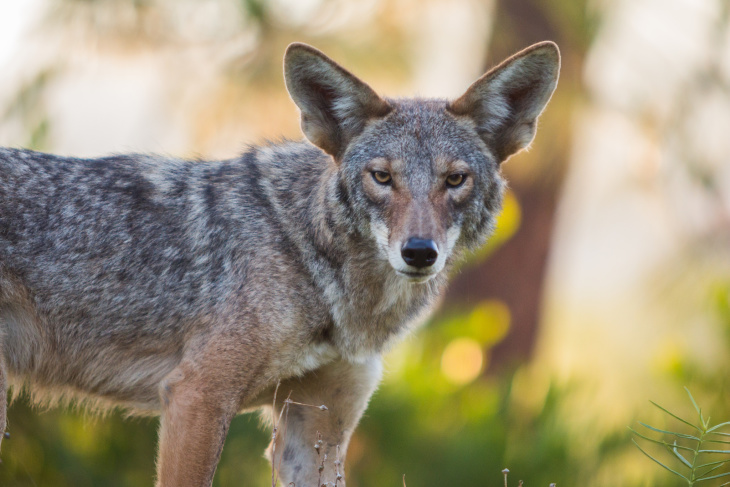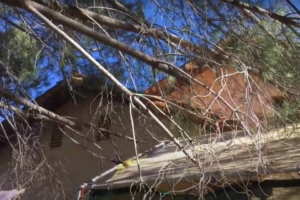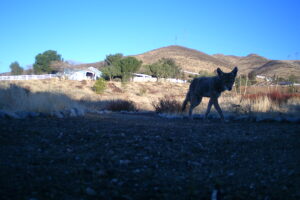Did you know you can help coyotes with mange? Call your local wildlife rescue. Here in Agua Dulce, CA, you can call or contact the Wild life care of Ventura: https://wildlifecareofventura.org. Mange is a parasite on the skin that makes coyotes very uncomfortable and sick if the skin gets infected. It´s not going to kill your dog or infect you. They don´t need to be euthanized or removed from their habitat.
Coyotes take advantage of bird baths to quench their thirst! if you have small pets or concerns about coyotes being close to you don´t have a bird bath or water sources for them.
Coyotes are more active at night, but can get used to humans and visit you during the day. Keep your pets indoors at all times.
Life History
From: A Comparison of Coyote Diets in Urban and Rural Habitats in the Piedmont of South Carolina. Bethany Krug. 2020
Coyotes are one of the eight recognized species in the genus Canis, three
of which are in the United States (Bekoff and Gese 2003). They have the ability to occupy numerous habitats all over the continental United States and many parts of Canada. These natural habitats include grasslands, deserts, mountains, and forests. Coyotes are identified by the blend of their gray and red pelage.They are typically smaller than gray wolves (Canis lupus). They can reach 1 to 1.5 meters in length depending on geographic location; coyotes in the northeastern United States tend to be larger than in the west (Bekoff and Gese 2003; Thornton and Murray 2014). They have an average lifespan of 13.5 to 15.5 years and occur in packs of anywhere from four to seven or more individuals, depending on food availability (Bekoff and Gese 2003).
Natural Diet of Coyotes
Coyotes choose habitats based on resource availability, especially food and water sources (Bekoff and Gese 2003). They are opportunistic omnivores who consume a variety of foods including fruits, invertebrates, birds,
rodents, lagomorphs and even large ungulates such as elk (Cervus canadensis) and moose (Alces alces) (Bekoff and Gese 2003).
Coyote dietary needs can be influenced by the presence of pups. A litter
can be up to six pups who don’t emerge from the den until around three weeks of age and reach adulthood around nine months (Bekoff and Gese 2003). When provisioning young after weaning, parents are required to consume more energetically “profitable” foods to sustain their pups (Bekoff and Gese 2003).
Coyote dietary needs are also under seasonal influence (Bekoff and Gese
2003). A study of urban coyotes conducted in Denver, Colorado, found that fruit was the most common component of coyote diet during summer (Poessel et al. 2017a). In addition, the authors found deer hair in summer, which they concluded was present due to predation on fawns during the time of scat collection; lagomorphs and rodents were the most common prey in winter (Poessel et al. 2017a). In Chicago, Illinois, a study of the diet of urban coyotes found that rodents were most common during breeding and pup-rearing seasons (Morey et al. 2007). In contrast to the Denver study’s findings, the Chicago researchers reported that deer were present throughout all seasons, possibly due to the availability of road-killed carrion (Morey et al. 2007).
Urban Coyote Life History
From: A Comparison of Coyote Diets in Urban and Rural Habitats in the Piedmont of South Carolina. Bethany Krug. 2020
The resource needs of coyotes can vary depending on geography. Current research reports conflicting accounts, likely due to regional differences in urbanization levels in our understanding of space use of urban versus rural areas. Most coyotes in urban areas occur as single individuals or in small packs that are either transient or have established large home ranges and smaller defined territories within. Those packs or individuals that establish a home range in urbanized landscapes often need larger territories to compensate for few available natural resources (Poessel et al. 2016). The Denver study found that coyotes made use of most land types that fell within their home range: rural, altered, and developed land (Poessel et al. 2016). Researchers in Chicago, using 11 radio collars, found that coyotes were more likely to have a home range in areas with less development and they commonly avoided the highly urbanized habitats (Gese et al. 2012). For those coyotes that do reside in urban areas, the presence of tree cover and riparian areas were noted to be significant aspects of their home ranges (Dodge and Kashian 2013; Gese et al. 2012). Tree cover is likely important for coyotes to remain hidden from humans in addition to the presence of prey along forest edges (Dodge and Kashian 2013). Riparian areas also provide cover and a source of vegetation and water (Gese et al. 2012). Urban territory use can vary between the sexes of coyotes. Compared with males, urban females often hold a bigger territory due to the need for densites (Poessel et al 2016). Female coyotes have even been observed denning in storm water drains suggesting that coyotes will use urban structures (Poessel et al. 2016). Both sexes are opportunistic in habitat selection, making use of frequently altered landscapes. A study in Detroit, Michcigan, reported evidence of coyotes taking advantage of urban areas that had reverted to more natural habitats due to economic decline in the region (Dodge and Kashian 2013).
Coyotes and pets
From: Baker RO, Timm RM. Coyote attacks on humans, 1970-2015: implications for reducing the risks. Human–Wildlife Interactions. 2017;11(2):3.
The fear of pets being injured or killed by coyotes (Canis latrans) can be a cause for pet-owner concern when coyotes are seen in neighborhoods, parks, or open spaces where pets range on or off-leash. While the risk of attack or predation to outdoor pets from coyotes is unknown, domestic dogs (C. lupus familiaris) and domestic cats (Felis catus) ave been found as food items in coyote diet studies. Pets appear to be a low percentage of coyote diet in urban areas (<3%; Lukasik and Alexander 2012, Poessel et al. 2017b), but Quinn (1997) estimated cats were 13% of urban coyote diet, and cat remains have seen found n 8% (Santana and Armstrong 2017) and 22% of coyote scats (Larson et al. 2015). Domestic dogs have generally been detected with <1% frequency of occurrence in coyote scats, suggesting predation is relatively rare (Morey et al. 2007, Larson et al. 2015, Murray et al. 2015, Santana and Armstrong 2017). Dogs may not be revalent in coyote diets, but several studies that have compiled reports of coyote conflicts with pets from the public, print media, and other sources include numerous reports of coyotes attacking or killing dogs (Grinder and Krausman 1998, Gehrt and Riley 2010, Alexander and Quinn 2011, Poessel et al. 2013).
Coyote interactions with dogs, importantly, do not consist solely of coyotes attacking or killing dogs. Kamler et al. (2003) observed 3 large dogs killing a coyote, and Andelt and Mahan (1980) observed a radio-collared male coyote playing with dogs on several occasions.
Baker RO, Timm RM. Coyote attacks on humans, 1970-2015: implications for reducing the risks. Human–Wildlife Interactions. 2017;11(2):3.
Mitigation strategies
From: Baker RO, Timm RM. Coyote attacks on humans, 1970-2015: implications for reducing the risks. Human–Wildlife Interactions. 2017;11(2):3.
One of the challenges in dealing with urban
coyote management is an absence of common understanding of the problems and of potential solutions, not only among suburban residents, but among decision-makers. Educating the public is a need often expressed by agencies and individuals att empting to solve such confl icts. However, in today’s society, reaching consensus on how to manage suburban wildlife involves not only eff ective biological solutions, but sociological, att itudinal, economic, and political challenges (Schmidt 2007).
Baker and Timm (1998) expressed the need for centralized record-keeping of coyote-caused human safety incidents so that cities, counties, and states could track this problem and have some objective means of measuring success of implemented management eff orts. White and Gehrt (2009) and Lukasik and Alexander (2011) noted a similar need for comprehensive reporting of coyote–human incidents. Localities that keep records of coyote confl icts can better pinpoint and respond to developing problems in specifi c neighborhoods. Consequently, they can concentrate timely eff orts in education and coyote management in ways that are more likely to reduce or prevent att acks on pets and humans, as officials have done in Glendale, California (Baker 2007), Austin, Texas, USA (Farrar 2007, 2016), and San Bernardino County, California, USA (N. Quinn, personal communication).
We list components of strategies that should be initiated to prevent coyotes from becoming habituated to humans, and to correct problem behavior when coyotes have become bold and ose potential human safety risks. The methods have been tested and proven over the last 25 years, and they are listed here in order of importance:
I – Programs to prevent coyotes from losing fear of humans
1.1 Public education to inform citizens about wildlife, what habitat components att ract animals, and eff ective hazing methods.
1.2 Development of statutes to prohibit feeding wildlife and regulate refuse handling
1.3 Develop coyote behavior monitoring regarding daytime activity, boldness to humans, pet losses, and human conflicts
1.4 Initiate coyote population reduction when needed
II – Programs to address existing bold coyote problems
2.1 Public education to warn about safety for humans and pets
2.2 Initiate coyote behavior monitoring to pinpoint and evaluate potential problems and specifi c target areas
2.3 If necessary, and when feasible, start trapping or shooting in specific target areas
2.4 Continue to monitor behavior, as trapping of 1 or 2 coyotes may reintroduce fear into the target coyote family group 2.5 Public education to eliminate components of att ractive habitats, such as food, water, shelter, and friendly humans (Baker 2007) Effectiveness of hazing.
When coyotes first venture into a suburban area, they likely have some degree of wariness toward humans. In this situation, certain hazing techniques may, when combined with modifications to make the environment less att ractive, reduce the chance that coyotes will lose their wariness of humans. Suburban residents who see a coyote in their neighborhood should att empt to frighten it away by shouting, throwing rocks, squirting it with a water hose, blowing portable air horns, or otherwise acting aggressively to reinforce its fear of people (Timm et al. 2007). Motion-sensitive lights on houses or outbuildings may deter coyotes from approaching.
Baker (2007) stated, “In observed coyote behavior at stages 1 and 2, a fair level of success was often obtained by using various hazing or aversive conditioning methods, when practiced consistently every time coyotes were observed close to humans. The eff ect could last for several months or even years. However, in stages 3 and beyond, any changes in coyote behavior due to hazing was usually temporary, only lasting a few weeks or months (depending on the methods used), unless one or more coyotes was trapped or shot” (389–390).
Without any real threat, many coyotes quickly adapt or habituate to sounds and to human activity. Recent research in suburban environments in the Greater Denver, Colorado, USA area has concluded that hazing at times can be a useful tool for short-term relief from a coyote encounter, but in other circumstances non injurious hazing may have little effect on coyote behavior, especially if the coyote has already become somewhat habituated to human presence (Bonnell and Breck 2017, Breck et al. 2017). Breck et al. (2017) noted:
“Unfortunately, because of the nature of urban coyote conflict, managers and the public often tend to ignore coyotes until an individual begins to show extreme forms of aggressive behavior. It is only after a problem individual develops that these techniques are implemented, and we believe this is a grave mistake that dooms the effectiveness of nonlethal methods”.
Baker RO, Timm RM. Coyote attacks on humans, 1970-2015: implications for reducing the risks. Human–Wildlife Interactions. 2017;11(2):3.




